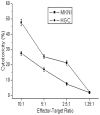Expression of immunoglobulin-like transcript (ILT)2 and ILT3 in human gastric cancer and its clinical significance
- PMID: 22246571
- PMCID: PMC3493079
- DOI: 10.3892/mmr.2012.744
Expression of immunoglobulin-like transcript (ILT)2 and ILT3 in human gastric cancer and its clinical significance
Abstract
Immune inhibitory receptors play an important role in organ transplantation, autoimmune diseases and cancers. Immunoglobulin-like transcript (ILT)2 and ILT3 belong to the inhibitory receptors of the ILT family, which have been reported to regulate a broad range of cellular functions involved in the immune response. They contain immunoreceptor tyrosine-based inhibitory motifs (ITIMs), which are related to immune regulation. Although ILT receptors have been studied in dendritic cells (DCs), T cells, NK cells and other cell types, the expression and clinical significance of ILT2 and ILT3 in gastric cancer have yet to be elucidated. Here, the expression of ILT2 and ILT3 in gastric cancer cell lines and pathologic tissues, as well as their effects on the cytotoxicity of NK92MI against the gastric cancer cell lines MKNI with ILT2lowILT3low and HGC-27 with ILT2highILT3high were detected. The results suggest that ILT2 and ILT3 are expressed with diverse degrees in gastric cancer cells and tissues, and the expression of ILT2 is related with differentiation and size of tumors. Furthermore, the cytotoxic activity of NK92MI against the MKNI cell line was stronger than that against HGC-27. This study indicates that ILT2 and ILT3 play a key role in gastric cancer immune escape, and ILT2 may be a new target in the clinical diagnosis and treatment of gastric cancer.
Figures




Similar articles
-
Human Leukocyte Antigen-G Inhibits the Anti-Tumor Effect of Natural Killer Cells via Immunoglobulin-Like Transcript 2 in Gastric Cancer.Cell Physiol Biochem. 2017;44(5):1828-1841. doi: 10.1159/000485819. Epub 2017 Dec 7. Cell Physiol Biochem. 2017. PMID: 29224003
-
Immunoglobulin-like transcripts ILT2, ILT3 and ILT7 are expressed by human dendritic cells and down-regulated following activation.Gene. 2004 Apr 28;331:159-64. doi: 10.1016/j.gene.2004.02.018. Gene. 2004. PMID: 15094202
-
Mutational analysis of immunoreceptor tyrosine-based inhibition motifs of the Ig-like transcript 2 (CD85j) leukocyte receptor.J Immunol. 2002 Apr 1;168(7):3351-9. doi: 10.4049/jimmunol.168.7.3351. J Immunol. 2002. PMID: 11907092
-
Inhibitory leukocyte immunoglobulin-like receptors: Immune checkpoint proteins and tumor sustaining factors.Cell Cycle. 2016;15(1):25-40. doi: 10.1080/15384101.2015.1121324. Cell Cycle. 2016. PMID: 26636629 Free PMC article. Review.
-
Inhibitory leukocyte immunoglobulin-like receptors in cancer development.Sci China Life Sci. 2015 Dec;58(12):1216-25. doi: 10.1007/s11427-015-4925-1. Epub 2015 Nov 14. Sci China Life Sci. 2015. PMID: 26566804 Review.
Cited by
-
Perspectives of targeting LILRB1 in innate and adaptive immune checkpoint therapy of cancer.Front Immunol. 2023 Sep 13;14:1240275. doi: 10.3389/fimmu.2023.1240275. eCollection 2023. Front Immunol. 2023. PMID: 37781391 Free PMC article. Review.
-
The Fibronectin-ILT3 Interaction Functions as a Stromal Checkpoint that Suppresses Myeloid Cells.Cancer Immunol Res. 2021 Nov;9(11):1283-1297. doi: 10.1158/2326-6066.CIR-21-0240. Epub 2021 Aug 23. Cancer Immunol Res. 2021. PMID: 34426457 Free PMC article.
-
Human leukocyte immunoglobulin-like receptors in health and disease.Front Immunol. 2023 Nov 13;14:1282874. doi: 10.3389/fimmu.2023.1282874. eCollection 2023. Front Immunol. 2023. PMID: 38022598 Free PMC article. Review.
-
The Genomic Organization of the LILR Region Remained Largely Conserved Throughout Primate Evolution: Implications for Health And Disease.Front Immunol. 2021 Oct 19;12:716289. doi: 10.3389/fimmu.2021.716289. eCollection 2021. Front Immunol. 2021. PMID: 34737739 Free PMC article. Review.
-
Elevated LILRB1 expression predicts poor prognosis and is associated with tumor immune infiltration in patients with glioma.BMC Cancer. 2023 May 4;23(1):403. doi: 10.1186/s12885-023-10906-2. BMC Cancer. 2023. PMID: 37142967 Free PMC article.
References
-
- Yonemura Y, Endou Y, Sasaki T, Hirano M, Mizumoto A, Matsuda T, Takao N, Ichinose M, Miura M, Li Y. Surgical treatment for peritoneal carcinomatosis from gastric cancer. Eur J Surg Oncol. 2010;36:1131–1138. - PubMed
-
- Jemal A, Siegel R, Ward E, Hao Y, Xu J, Thun MJ. Cancer statistics, 2009. CA Cancer J Clin. 2009;59:225–249. - PubMed
-
- Kawaida H, Kono K, Takahashi A, Sugai H, Mimura K, Miyagawa N, Omata H, Ooi A, Fujii H. Distribution of CD4+CD25(high) regulatory T-cells in tumor-draining lymph nodes in patients with gastric cancer. J Surg Res. 2005;124:151–157. - PubMed
-
- Gross S, Walden P. Immunosuppressive mechanisms in human tumors: Why we still cannot cure cancer. Immunol Lett. 2008;116:7–14. - PubMed
-
- Hirokawa K, Utsuyama M, Ishikawa T, Kikuchi Y, Kitagawa M, Fujii Y, Nariuchi H, Uetake H, Sugihara K. Decline of T cell-related immune functions in cancer patients and an attempt to restore them through infusion of activated autologous T cells. Mech Ageing Dev. 2009;130:86–91. - PubMed
Publication types
MeSH terms
Substances
LinkOut - more resources
Full Text Sources
Other Literature Sources
Medical

